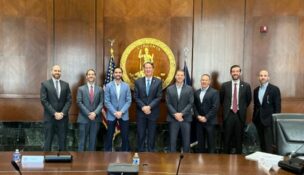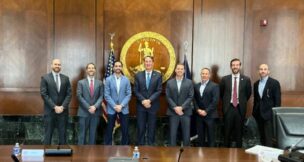Trump says US gets rare earth minerals from China and tariffs on Chinese goods will total 55%

President Donald Trump speaks to reporters after arriving on Air Force One, Tuesday, June 10, 2025, at Joint Base Andrews, Md. (AP Photo/Alex Brandon)

President Donald Trump speaks to reporters after arriving on Air Force One, Tuesday, June 10, 2025, at Joint Base Andrews, Md. (AP Photo/Alex Brandon)
Trump says US gets rare earth minerals from China and tariffs on Chinese goods will total 55%
SUMMARY:
- Trump announces 55% U.S. tariffs under China trade framework.
- China to supply rare earth minerals and magnets up front.
- Deal includes loosening restrictions on Chinese students.
WASHINGTON (AP) — President Donald Trump announced Wednesday that the United States will get magnets and rare earth minerals from China under a new trade framework and that tariffs on Chinese goods will total 55%.
In return, Trump said, the U.S. will provide China “what was agreed to,” including allowing Chinese students to attend American colleges and universities. The Republican president had recently begun to clamp down on the presence of Chinese nationals on U.S. college campuses.
What Trump described as a “deal” actually is a framework to help the U.S. and China eventually negotiate a sought-after trade agreement, which Trump intends to do with numerous countries but so far has been unable to execute on as quickly as he promised the public he’d be able to.
So far, Trump only has announced the terms of a deal with the United Kingdom.
A White House official, who was not authorized to discuss the terms publicly and insisted on anonymity to describe them, said the 55% was not an increase on the previous 30% tariff on China because Trump was including other pre-existing import taxes.
“OUR DEAL WITH CHINA IS DONE, SUBJECT TO FINAL APPROVAL WITH PRESIDENT XI AND ME.,” Trump wrote Wednesday on his social media site.
He said full magnets and any necessary rare earths will be supplied up front by China.
“WE ARE GETTING A TOTAL OF 55% TARIFFS, CHINA IS GETTING 10%. RELATIONSHIP IS EXCELLENT!” Trump wrote.
A Chinese statement on the talks did not reveal any details or concrete steps.
In a follow-up social media post, Trump said he and Xi “are going to work closely together to open up China to American Trade. This would be a great WIN for both countries!!!”
Senior U.S. and Chinese negotiators announced late Tuesday in London that they had agreed on a framework to get their trade negotiations back on track after a series of disputes that threatened to derail them.
The announcement came at the end of two days of talks in the British capital that wrapped up late Tuesday.
It also came as an international rights group said that several global brands are among dozens of companies at risk of using forced labor through their Chinese supply chains because they use critical minerals or buy minerals-based products sourced from the far-western Xinjiang region of China.
The report by the Netherlands-based Global Rights Compliance says companies including Avon, Walmart, Nescafe, Coca-Cola and Sherwin-Williams may be linked to titanium sourced from Xinjiang, where rights groups allege the Chinese government runs coercive labor practices targeting predominantly Muslim Uyghurs and other Turkic minorities.
The report found 77 Chinese suppliers in the titanium, lithium, beryllium and magnesium industries operating in Xinjiang. It said the suppliers are at risk of participating in the Chinese government’s “labor transfer programs,” in which Uyghurs are forced to work in factories as part of a long-standing campaign of assimilation and mass detention.
Asked about the report, the Chinese Foreign Ministry said that “no one has ever been forcibly transferred in China’s Xinjiang under work programs.”
The named companies didn’t immediately comment on the report.
Trump’s announcement showed that his tariff rates continue to be a moving target, rather than a transparent policy tool used to both raise revenues and clearly extract better terms in trade.
The U.S. president continues to take a mercurial approach to tariffs, threatening to change the rates in ways that trading partners find to be random. He recently doubled his steel and aluminum tariffs to 50%, possibly increasing costs for U.S. manufacturers and construction companies that rely on the metals as raw materials.
He threatened a 50% tariff on the European Union under the belief that it would jumpstart talks, only to back down as his self-imposed 90-day negotiating period is set to expire around July 9. A separate 90-day negotiating period with China is set to end in mid-August.
But Trump could change those dates and tariff rates as he has stressed the importance of flexibility over certainty. The president next week will attend the Group of 7 summit in Canada with other leading trade partners he has kept in limbo over his trade policies.
On Tuesday night, Trump won what he said was a “great and important” win when a federal appeals court ruled that the government can continue to collect his sweeping import taxes while challenges to his trade policy work their way through the courts.
There are still lingering tensions between China and the U.S. on overarching economic goals. The Trump administration wants more manufacturing to occur domestically while using tariff revenues to fund its income tax cuts, while China wants to continue its technological ascent and move beyond its advancements in electric vehicles to developing artificial intelligence.
The Trump administration has played down the risk of tariffs worsening inflation. Shortly after Trump announced the framework with China, the Labor Department said consumer prices rose at an annual rate of 2.4%, with the cost of autos and apparel falling on a monthly basis in a sign that any economy-wide inflation from the tariffs has yet to appear.
e
















